Book Reviews (2012) by Joseph M. Sherlock
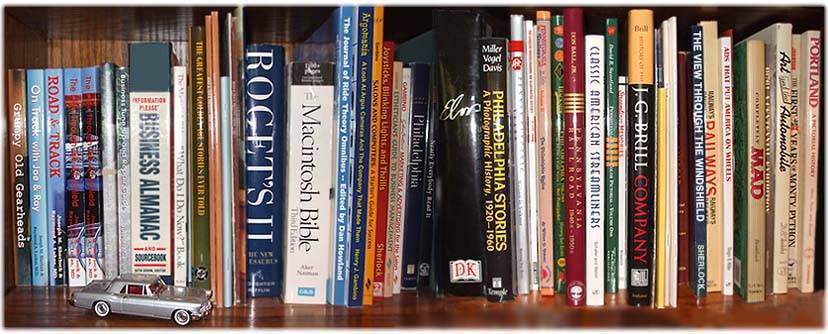
More recent book reviews can be found here.
'Bonhoeffer: Pastor, Martyr, Prophet, Spy' by Eric Metaxas
Dietrich Bonhoeffer was a German Lutheran pastor, theologian and anti-Nazi dissident. He was a founding member of the Confessing Church - a schismatic German church that arose in opposition to the Nazification of the state-controlled Lutheran church. He strongly opposed Hitler's euthanasia program and genocidal persecution of the Jews. He and his colleagues worked to get Jews safely out of Germany as persecutions increased.
Bonhoeffer was peripherally involved in plans by certain members of the German Military Intelligence Office to assassinate Adolf Hitler. Dietrich was imprisoned and, after two years, executed by the Nazis. It is not clear why he was killed; there was no trial and there seems to be little evidence that Hitler's regime was aware of his role in the failed assassination plot. He may have been eliminated simply because he was a dissident.
The book is very comprehensive - too much so in my opinion. There is much tedium and rambling by the author. Trying to finish the book often seemed more like a chore than a pleasurable read.
Nevertheless, I learned much, not only about Dietrich Bonhoeffer but about the conflict between church and state in 1930-40s Germany. This interesting story would have been better served by a well-organized 300-page hardback rather than Metaxas' 500-plus page snorer. (posted 12/28/12, permalink)
'Into The Fire: A Firsthand Account of the Most Extraordinary Battle in the Afghan War' by Dakota Meyer and Bing West
Medal of Honor recipient Dakota Meyer relates his personal story of his time in Afghanistan. In Fall 2009, Taliban insurgents ambushed a patrol of Afghan soldiers and Marine advisors in a small mountain village called Ganjigal. Operating from entrenched, elevated positions in the surrounding mountains, the enemy had over one hundred men pinned down in the village and was picking them off with ease. Repeated requests for air support were refused by military higher ups. Ordered to remained behind, 21 tear-old Marine corporal Meyer disregarded orders and moved in to rescue his comrades. Over the course of five hours, he bravely fought his way into the streets of Ganjigal. Unable to save all his friends, Meyer - for his bravery in action - became the first living Marine in three decades to be awarded the Medal of Honor.
This is a moving book that takes the reader to the heart of the battlefield. Meyer's story highlights the confusion and horror which are part of military combat. We see the frustration and tragedy wrought by the oft-wrongheaded decisions, policies and rules of engagement dictated by those military commanders who are not on scene.
Regardless of your feelings about the Afghan war, you will - after reading this work - salute the brave men and women that serve our great nation. Recommended. (posted 12/20/12, permalink)
'The Lawgiver' by Herman Wouk
This is a novel about writing a book about Moses. No, wait. It also about making a movie about Moses based on a book which has yet to be written. The story is told through memos, faxes, e-mails and notes, many in annoying typefaces. Were this the work of an unknown author, it would have never been published. Or, if printed, it would have quickly made its way to the remainder bins.
But ... but it's by that famous author, Herman Wouk. The large type on the back cover makes sure that you know that: "Winner of the first Lifetime Achievement Award from the Library of Congress." Wouk is described as "a treasure." The word Epic is used. Yes, yes, he wrote 'The Caine Mutiny' but that was 61 years ago. His most recent effort is far below par.
Well, everybody makes mistakes. Burt Bacharach penned the song, 'The Blob', in 1958. In the 1970s, many otherwise-manly males were seen wearing lime-green leisure suits. In the 1980s, Cadillac made the Cimarron. Halle Berry starred in 2004's 'Catwoman'. In 2012, it was Apple Maps.
Wouk's book is mildly amusing but it's so Jewish that it is hard to comprehend some sections if you're not of the Hebrew persuasion. Mel Brooks knows how to do shtick for Gentiles. Wouk doesn't.
Verdict: Oy vey! The Lawgiver's a turkey ... a Kosher one. (posted 12/14/12, permalink)
'Thomas Jefferson: The Art of Power' by Jon Meacham
In 1962, at a dinner honoring Nobel Prize Winners of the Western Hemisphere, President John F. Kennedy famously said, "I think this is the most extraordinary collection of talent, of human knowledge, that has ever been gathered together at the White House, with the possible exception of when Thomas Jefferson dined alone." He continued, "Someone once said that Thomas Jefferson was a gentleman of 32 who could calculate an eclipse, survey an estate, tie an artery, plan an edifice, try a cause, break a horse, and dance the minuet."
Politicians and pundits of all persuasions have embraced and honored Jefferson for their own purposes. This fascinating, detailed book shows us Jefferson the politician and president, a complex human being forever engaged in the disputes, wars and difficulties of his era.
School-taught history places Jefferson on quite a pedestal - or, more accurately, Mt. Rushmore - and the fog of condensed history makes him seem like a convivial and brilliant chap who palled around with other larger-than-life figures: George Washington, John Adams, Ben Franklin and Alexander Hamilton. Not so. Jefferson and Hamilton were always at odds. Jefferson and Adams didn't speak to one another for years. Over his lifetime, Thomas Jefferson had arguments with all of them.
Much of the book examines the unfolding disagreement between Federalists, who desired a closer relationship with England and rule by the privileged (later, some wanted to secede), and Democrats, who sought individual freedom. There is also much discussion about slavery; using today's vernacular, Jefferson flip-flopped on this issue several times during his life and always owned slaves.
Meacham has written, "The real Jefferson was like so many of us: a bundle of contradictions, competing passions, flaws, sins and virtues that can never be neatly smoothed out into a tidy whole." But, amidst the flaws and shortcomings, his erudition, influence and leadership shine through.
This is a fairly thorough and fascinating book about a complex, historic figure. Recommended. (posted 12/12/12, permalink)
'Mugged: Racial Demagoguery from the Seventies to Obama' by Ann Coulter
On television, Ms. Coulter is a bombastic flame-thrower of sound bites. In book form, she is caustic at times but supports her positions with well-researched facts (35 pages of citations and notes).
In this book, Ann examines the race-husting, self-serving liberals who populate Democratic party, the black race-baiters who cry 'racist' every time things don't go their way (or when their 'business' is slow). If Al Sharpton were white, he'd be a shunned, disgraced figure who would never be allowed to appear on television.
The white tiptoe-on-eggshells approach to blacks began in the mid-1960s, resulting in the rise of the black welfare state, oversensitivity in dealing with black failings, affirmative action and political correctness to the Nth degree. Ann Coulter wrote it; I lived it and witnessed it.
Coulter emphasizes the other Fact That Dares Not Speak Its Name: that the Democrat Party had been the party of Southern segregationists, while Republicans did the most for civil rights and integration.
The fear of politicians and liberal reporters and allowed the execrable Move ruckus in Philadelphia to go on for seven years, while self-described "black liberation group" Move terrorized their poor black neighbors, while putrefying the neighborhood with their disgusting sanitary habits. Finally, the police blew up the neighborhood while trying to bomb an armed fortress on Move's roof, causing several dozen families to loose their homes.
The tiptoeing and 'white guilt' began to evaporate following the O.J. Simpson verdict - the race-based acquittal of a spectacularly guilty black celebrity - when blacks across the nation cheered O.J. and whites were appalled.
Ann Coulter fearlessly documents the real history of mishandled race relations, providing case-by-case examples of how corrupt black leaders and liberal cohorts whitewash the guilty, accuse the innocent and foment racial hatred to serve their own selfish interests.
Recommended. (posted 12/4/12, permalink)
'Wait: The Art and Science of Delay' by Frank Partnoy
In this work, the author offers scientific studies, interviews with military, sports and romance experts to support his theory that sometimes waiting rather than jumping to conclusions is best. Well, duh.
The book offers some interesting anecdotes but is a bit short in the practical advice department. A fast internet connection is great but playing a 45 record at 78 rpm speed is usually a hilarious, but fast-paced disaster. Partnoy suggests that the value found in waiting relies on a certain adroitness. But when to act? And how long can you afford to wait before adverse consequences kick in? Beats me.
I think that, when it comes to decision making, the old Kepner-Tregoe matrix offers the best approach in most cases and allows one to be decisive but rational.
Verdict: I say pass on this book. (posted 11/28/12, permalink)
'Killing Kennedy: The End of Camelot' by Bill O’Reilly and Martin Dugard
I was looking forward to this book, having read the authors' previous work, 'Killing Lincoln' and finding it to be a well-written page-turner.
 Sadly, 'Killing Kennedy' was a disappointment. It was lacking in the detail and the sheer can't-put-it-down excitement of the earlier book. Some of the phrasing was over the top: "a gob of violent spit." I didn't know that phlegm could be so berserk and destructive. Sadly, 'Killing Kennedy' was a disappointment. It was lacking in the detail and the sheer can't-put-it-down excitement of the earlier book. Some of the phrasing was over the top: "a gob of violent spit." I didn't know that phlegm could be so berserk and destructive.
In the preface, O'Reilly pointed out - in an I Was There kinda way - that he was a teenager in high school on the day JFK was assassinated, as if his very adolescent sentience somehow anointed him as an expert. BFD. I was a student on November 22, 1963 but I was as many miles away from Dallas on that day as Teen Billy was. Neither of us were in Dallas on that tragic November day.
Here's an execrable excerpt: "The absence from the life of his newborn daughter is something Marina and the baby will have to get used to. Because Lee Harvey Oswald will not be around to watch young Audrey Rachel Oswald grow up." Give me a break ... this sounds like the just-before-the-commercial teaser on 'Behind The Music'. Or 'Inside Edition'. Speaking of 'Inside Edition', the book contains far too much gossipy, salacious material concerning JFK's sex life and Jackie's fashion-consciousness and secret smoking habit.
Ultimately, the author's No-Spin Policy is abandoned for a condensed, dumbed-down and novelized version of the Warren Report. William Manchester wrote a far more detailed chronicle of JFK's murder.
The original, official investigation of the assassination itself was seriously flawed - inconvenient leads were ignored, laws of physics were violated and contrary findings were swept under the rug. Serious doubt was cast on the Warren Commission findings by the U.S. House Select Committee on Assassinations in the late 1970s but this is not mentioned in O'Reilly's work. In fact, the authors ignore all conspiracy avenues after a just-before-the-assassination tease about Kennedy being hated by Castro, many Cubans in the U.S., the Mafia, Frank Sinatra, the CIA and TAB diet cola, which debuted in 1963. (I may have made that last one up.)
O’Reilly and Dugard rapidly conclude that Oswald did it all by himself because he was a Commie loser who wasn't getting enough sex. In 1963, the government (with the press in the cheering section) did the same thing - wrapping up the JFK's murder in a tidy little package as quickly as a Perry Mason episode. They "solved" the murder before JFK was even in the ground (and made sure that the lone official suspect was conveniently and quickly disposed of by a Mafia thug friendly to the Dallas police) but many of us never believed that a chinless little wimp with a cheap rifle could pull off such a thing by himself.
If you're interested in details and discrepancies surrounding the killing of JFK, there have been many good books written over the years; I've probably read twenty or so and would recommend 'High Treason: The Assassination of President John F. Kennedy - What Really Happened' by Groden and Livingstone, published in 1989. It's a good starting point and an eye-opener.
As for 'Killing Kennedy' ... frankly, it's not much of a book. Skip it. That's the truth ... because The Spin Stops Here. (posted 11/21/12, permalink)
'Custer' by Larry McMurty
This is an incomplete, disjointed, abysmally-written and boring book. I don't care if McMurty once won a Pulitzer; this dreck reads as if it were dictated in a stream-of-consciousness, drunken stupor to some suffering stenographer.
You'll find references to Buffalo Bill, Billy the Kid, Sitting Bull's late-in-life lust for Annie Oakley, Pat & Dick Nixon, rusted cars in Montana and other irrelevance in this all-over-the-place waste-O-pulp. This work is supposed to be part biography, part coffee table book and it fails at both. The photos are poorly captioned and are placed out of context with reference to the text. I kept looking at pictures and asking, "Where's Custer?" Maybe it's supposed to be a takeoff on those old 'Where's Waldo' books.
I guess should have known better. Back in the 1980s, I struggled through 'Lonesome Dove', reading the paperback version during a Hawaiian vacation. It got rave reviews but I found it tedious. 'Custer' is not just a step down from 'Dove', it's a painful tumble down three flights of stairs.
Verdict: Pee yeeeewwww. (posted 11/19/12, permalink)
'The Lost Bank' by Kirsten Grind
Robert Frost once wrote, "A bank is a place where they lend you an umbrella in fair weather and ask for it back when it begins to rain."
Having owned a few businesses, I have a pretty good understanding how most companies work (know your costs, watch your expenses, hire good people, be nice to customers and prospects) but - in almost 55 years worth of transactional experiences - I've never figured out what makes for a successful bank. Many of financial institutions that have treated me badly seemed to succeed anyway, while many of those banks that were top-notch - in my book - have disappeared.
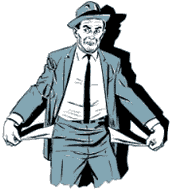 This book is about the failure of Washington Mutual, a once-sleepy Seattle-based savings-and-loan that wanted to become a giant. The bank bet big and failed - spectacularly. In the late 1980s, I took a home mortgage with WaMu - an uncomplicated 25 year fixed one. When rates dropped by 3% a few years later, I met with a loan officer to refinance at a lower rate. Washington Mutual's fees were exorbitant and uncompetitive, served with a dose of attitude and arrogance. I took some money out of the market, paid off the WaMu bozos, closed all my accounts and never looked back. It may not have been the optimal thing to do from a financial planning standpoint but there is a real pleasure to be taken from actually owning your own home - free and clear. This book is about the failure of Washington Mutual, a once-sleepy Seattle-based savings-and-loan that wanted to become a giant. The bank bet big and failed - spectacularly. In the late 1980s, I took a home mortgage with WaMu - an uncomplicated 25 year fixed one. When rates dropped by 3% a few years later, I met with a loan officer to refinance at a lower rate. Washington Mutual's fees were exorbitant and uncompetitive, served with a dose of attitude and arrogance. I took some money out of the market, paid off the WaMu bozos, closed all my accounts and never looked back. It may not have been the optimal thing to do from a financial planning standpoint but there is a real pleasure to be taken from actually owning your own home - free and clear.
Interestingly, WaMu's loan officer had looked up my balance, remarking, "Wow. This is surprising. We haven't sold-off your loan - that's rare." The idea of 'selling off' a local borrower's loan to someone thousands of mies away seemed to be a violation of the traditional 'know your buyer, know your market' rule but Washington Mutual thought they knew better. It turned out they didn't and that's what killed them.
In a quest for growth, WaMu moved out of the Northwest into the rocky, volatile California market and acquired Long Beach Mortgage, a sub-prime lender. Sloppy loan-making and sloppy oversight poisoned the bank. Steven M. Knobel, a founder of appraisal firm Mitchell, Maxwell & Jackson recalled: "It was the Wild West. If you were alive, they would give you a loan. Actually, I think if you were dead, they would still give you a loan."
Option ARMs soon became WaMu's most profitable mortgage product. It was poorly understood by borrowers. Teaser rates were as low as 1% for the first month, options to just pay just the interest, or even less - a 'minimum payment' covering just part of the interest for a while were part of the draw. After five years, the loan would recast to normal rates and payment terms, shocking those suckers who thought the good times would never end. Many of these recastings occurred just after the real estate bubble burst, leaving buyers underwater and unable to afford the higher payments.
In the midst of all the growth and turmoil, Kerry Killinger, WaMu's president and CEO, had a midlife crisis at about age 50, ditching his college-sweetheart wife and his/her frugal ways. He quickly married a free-spending woman with expensive tastes and traded-in his coach class tickets for private jets.
There is much discussion in author Grind's book about the role of Federal regulators and their 'hear-no-evil, see-no evil' attitude when problems started and later turf battles between federal agencies, particularly the FDIC and the Office of Thrift Supervision. There is insufficient discussion about why WaMu was allowed to fail, while far-sicker financial institutions were given a bailout. Politics, I think, played a big role here and many small banks were thrown to the wolves while politically protected institutions were favored with significant government help. While not covered in the book, just look at the treatment of California Representative Maxine Waters' OneUnitedBank versus that of the once-prosperous Bank of Clark County.
While I generally enjoyed this book, I sometimes found the story confusing and convoluted. I had trouble figuring out what exact time period we were in, especially early in the story - prior to 1995. The 'nice guys turned to clueless baddies' narrative was difficult to swallow. I found the author's portrayal of 1980s' WaMu under the 'benevolent' leadership of Lou Pepper to be pollyannaish - especially since she based much of that era's story on Pepper's self-serving book.
Nevertheless, 'The Lost Bank' makes for an educational read that should raise your level of cynicism when it comes to financial institutions of all stripes. (posted 11/15/12, permalink)
'The Real Crash: America's Coming Bankruptcy - How to Save Yourself and Your Country' by Peter Schiff
In this book, author Schiff posits that America is currently in a ready-to-explode government-inflated bubble. When it bursts, the consequences for the economy and Americans will be catastrophic. While I agree that our national debt is waaaay too high and Bernacke's ultra low-interest rates are unsustainable, I am unconvinced that we're at the 'hoard gold, print militia money' stage.
I think that this book is a cover to promote Mr. Schiff's investment advisory firm. I also feel that his solutions - "Eliminate the FDA!", "Return to the gold standard!", "Get rid of Social Security and Medicare!", etc. - are impractical and unrealistic. Recommendations are sparse - one chapter out of 28 - and there are few actionable investment suggestions.
Skip this book - there are better ways to spend your time. (posted 11/9/12, permalink)
'Cowards' by Glenn Beck
Where does one begin? In my mind, Beck began as a quirky CNN program host, moved to Fox where he was unleashed and spouted everything from quiet logic to zany craziness to Ray Bell-like paranoia. Then he bailed on Fox, moved to Texas and started his own subscription TV service. He's definitely an uneven guy, like that half-loony acquaintance that you sometimes agree with and then wonder if you're crazy, too.
This is not a useless work but, like Glenn, it is uneven. I found parts of the book uninteresting and did not feel compelled to plow through to the next chapter. Part of the problem was the off-putting images and graphics including the odd, Dymo labelmaker sub-section titles/headlines.
The book's title apparently comes from Glenn Beck's new strategy of labeling anyone who disagrees with him or refuses to echo his beliefs as a coward. Beck begins by beating up old Teddy Roosevelt for being a progressive. But he soon attacks the two popular parties of today, enumerating their shortcomings and promoting libertarianism as the true alternative. As much as I may like some of those ideas, a libertarian president or congress is about as likely as Esperanto becoming the official language of the United States.
This book raised some good points here and there but did not offer any serious, thoughtful solutions. Verdict: Read something else. (posted 11/2/12, permalink)
'The New Leviathan: How the Left-Wing Money-Machine Shapes American Politics and Threatens America's Future' by David Horowitz and Jacob Laksin
This was a very enlightening read. The book illustrates how seemingly-benign nonprofits and foundations have been infiltrated by the left. It presents an unsettling picture of the vast power and financial resources used to pump money into leftist causes and candidates.
About a third of the book's pages are reference, filled with statistics and tables supporting the authors' claims. This is a must-read for anyone trying understand how such organizations are destroying the rights of the people and attempting make America a Socialist nation.
Eye-opening and recommended. (posted 10/25/12, permalink)
'The Road to Freedom' by Arthur C. Brooks
In this book, American Enterprise Institute President Arthur C. Brooks argues that the socialistic redistribution trend of recent times cannot be reversed through greed-is-good appeals about the economic efficiency of capitalism. Instead, he believes that free enterprise requires a moral defense based on the attributes of earned success, equality of opportunity, charity and basic fairness.
While Brook's principles are correct, the book itself is rambling and boring. Conservatives - probably the vast majority of buyers of this book - will find nothing new brought to the table. Milton Friedman has written about all of this years ago - better, more succinctly and without the squishy, tedious moralizing. (posted 10/19/12, permalink)
'Treacherous Beauty: Peggy Shippen, the Woman behind Benedict Arnold's Plot to Betray America' by Mark Jacob and Stephen H. Case
"Peggy who?" you ask. I did too. And what about Benedict Arnold? "Traitor." That's all I remember, too.
'Treacherous Beauty' is a biography of comely 18th Century Philadelphia society girl Peggy Shippen, who married Benedict Arnold. She was instrumental in the plot to sabotage the American Revolution.
Benedict Arnold's story is told as well. A once heroic Colonial figure who fought beside George Washington, Arnold becomes frustrated when his ego isn't satisfied. He begins with self-justified larceny and, later, betrays newly-created America and supports the British war effort.
He was far from alone in having Loyalist sympathies. I was reminded of what I had read in 'Declaration: The Nine Tumultuous Weeks When America Became Independent, May 1-July 4, 1776' by William Hogeland: "In May 1776, the Continental Congress had no serious intention of breaking off from England. But the furtive, behind-the-scenes, conspiratorial activity of Samuel Adams, John Adams and cohorts to overturn the Pennsylvania government made the difference and reversed the sentiment."
Meanwhile the beautiful but unstable Peggy Arnold charmed everyone, including George Washington and Alexander Hamilton in attempt to keep them from looking too closely at her husband's activities. The Founding Fathers held the common view that women lacked the sophistication for treason. Scheming Peggy took full advantage of that viewpoint.
This fast but fascinating read will add to your knowledge of the fragile American Revolution. Recommended. (posted 10/15/12, permalink)
'The Presidents Club: Inside the World's Most Exclusive Fraternity' by Nancy Gibbs and Michael Duffy
This fascinating book discusses the relationships between various presidents - friendships and/or bitterness that last long after they are gone from the White House. Beginning with Herbert Hoover and ending with a partial report on Barack Obama, the reader is presented with sides of presidents not previously unseen.
I thought the authors presented even-handed accounts with seemingly no political biases. The book is full of inside information, including Reagan teaching Clinton how to do a proper military salute. (I don't think Clinton was ever that good at saluting, even after tutoring.) This hardback confirmed that Jimmy Carter was considered a meddling pain-in-the-ass by just about everyone.
This book is not overly long but it is weighty and full of meat. It doesn't lend itself to speed reading.
If you have even the slightest interest in presidential politics or history, you'll enjoy 'The Presidents Club'. (posted 10/12/12, permalink)
'Engines Of Change: A History of the American Dream in Fifteen Cars' by Paul Ingrassia
The book purports to offer "a wondrous epic in fifteen automobiles," according to the jacket, including the Ford Model T, LaSalle, 1953 Corvette, VW Beetle, Chevrolet Corvair, Pontiac GTO, Honda Accord, Toyota Prius and others. The author connects various car models to society's cultural shifts.
Remember in 'Animal House' when John 'Bluto' Blutarsky gave a rousing, if inaccurate speech? ("Was it over when the Germans bombed Pearl Harbor? No!") Frat brother Boon waves away the historical error, noting "Forget it, he's rolling." Soon, the whole Delta House is yelling, "Let's do it! Let's do it!" Ingrassia's book begets the same kind of Blutoesque enthusiasm, despite its many inaccuracies.
Let's get some of those errors out of the way first:
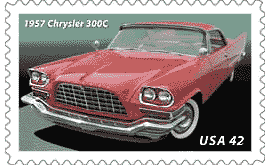 • A photo, one of over fifty in the book, shows the Dodge display at the 1955 Detroit Auto Show. It is incorrectly identified as the 1957 auto show and mention is made of the tall tail fins. The 1957 Dodge models did indeed have prominent fins but the two '55 convertibles shown in the photo sport only tiny, prehensile ones. • A photo, one of over fifty in the book, shows the Dodge display at the 1955 Detroit Auto Show. It is incorrectly identified as the 1957 auto show and mention is made of the tall tail fins. The 1957 Dodge models did indeed have prominent fins but the two '55 convertibles shown in the photo sport only tiny, prehensile ones.
I think a photo of the '57 Chrysler would have been more dramatic.
• On page 10, the author states that the Ford Model T was the first car to use interchangeable parts. Not so. The first car to use fully interchangeable parts was Henry Leland's Cadillac Model K. Leland became an interchangeability enthusiast while working at gun-maker Colt in the 19th Century. He later founded Lincoln and, ironically, soon sold it to Ford.
• On page 32, it is stated that the Corvette debuted in December 1953. After being displayed at the February '53 New York Auto Show as a concept car to rave reviews, the first production Corvette rolled off a makeshift assembly line in Flint, Michigan on the very last day of June 1953. Only 300 '53 models were made.
• In an example of hyberbole meeting misplaced enthusiasm, GM engineer Zora Arkus-Duntov is described by the author as "a lesser-known young rebel of the day," referring to both 1953 and Elvis Presley. The truth is, Elvis was a pimply-faced teenaged truck driver and wannabe singer at the time - his national fame would come a few years later. Zora was hardly young; he was a middle-aged age 44 in 1953. Duntov's fame in automotive circles would come a few years later, too.
• Page 51 contains these sentences about singer Jan Berry - of the Jan and Dean duo - and the crash of his Corvette Sting Ray: "He would be partly paralyzed for life. The tragedy only added to the Corvette's status." I found this 'status' remark to be untrue, offensive and maudlin.
• The Chrysler Norseman concept car was in the hold of the ill-fated Andrea Doria when the ship sunk in July 1956. According to the author, the lost Ghia-built vehicle was built at "the then astronomical cost of $100,000." Meh. The Ghia-built 1955 Lincoln Futura cost $250,000.
I don't think the Norseman even deserved a mention; it was hardly a groundbreaking conceptual design. Most of the truly eye-popping and/or technically-interesting dream cars of the era (the Firebird turbine cars, Buick XP-300 and LeSabre, Pontiac Club de Mer, Cadillac Cyclone, etc.) were conceived by General Motors.
• On page 71, in reference to Cadillac styling, you'll find this sentence: "The fins on the 1957 models appeared slapped on as afterthoughts." Really? Take a look at this photo of a '57 Caddy:
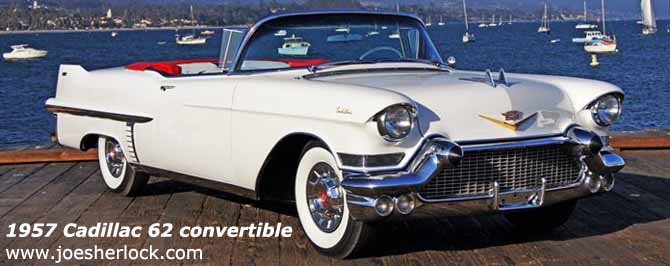
It hardly matches the author's description.
• Discussing the Tucker automobile, there's this: "Tucker's venture collapsed because his cars weren't reliable."
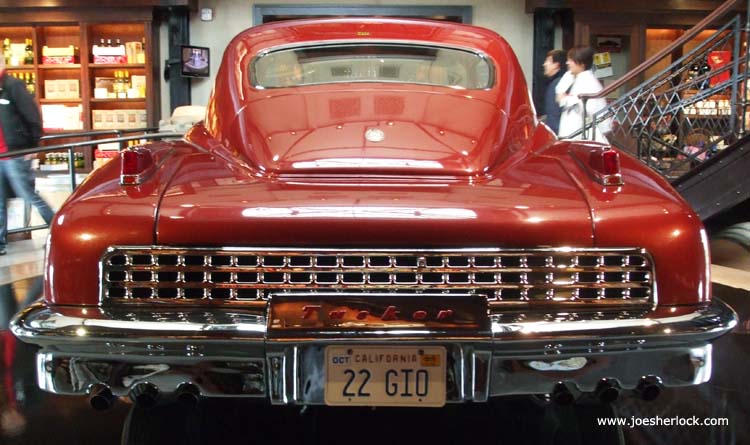
Huh? All auto historians I've ever read claim that the Tucker failed because the firm ran out of money. Preston Tucker's venture was underfunded from the get-go.
• Ingrassia states that, in the 1940s, Ford's financial systems were so primitive that the company paid its bills "by stacking them up, weighing them and writing checks based on the dollars per pound of paper." This assertion is ridiculous. What actually happened was that the firm estimated its accounts payable on a daily basis by weighing invoices. Hardly a precise method but far less silly than what Ingrassia would have you believe. No money was ever disbursed based on these payables estimates.
• On page 160, the author states that the 'Bullitt' Mustang was a Shelby GT model - a mortal sin in the eyes of the Mustang Faithful.
• Page 183, the Beatles 'Let It Be' is hailed as "hymn to finding comfort amid chaos." Actually, it was a song about the effects of marijuana.
• The Gremlin was "born on April Fool's Day 1970 and died in 1980." The AMC Gremlin was discontinued in 1978.
• Of the first-generation BMW 2002, Ingrassia wrote, "Its four-speed manual transmission could stay in second gear until the car hit sixty miles per hour, whereas most American cars groaned to upshift at 30 mph." Is he kidding? My dad's 1956 Ford Mainline could do close to 60 mph in second gear, even with a 4:11 rear axle.
My '63 Corvette could hit 60 in first gear with its four-speed box. Even my first 1939 Plymouth with its underpowered, oil-burning, at-death's-door six-cylinder flathead motor could do 45 mph in second.
• The author's claim that Henry Ford II tried to buy BMW in 1987 seems unlikely. Hank the Deuce retired from active service at Ford in 1982 and died in September 1987. I've been unable to confirm this tale elsewhere.
• On page 274, Ingrassia wrote about Kaiser-Willys: "By 1956, the company decided to stop making regular cars, including the woeful Henry J, and to focus exclusively on Jeep." While not a flatly false statement, the author has oversimplified the timeline. The Henry J was discontinued in 1954, Kaiser stopped making autos in April 1955 and the Willys Aero was gone after the '55 model year.
• Nehru jackets are described as a product of the "Seventies." I think that by 1970 or so this mid-60s fad item was mostly worn by those who got their clothing from Salvation Army bins.
• In a section on pickup trucks and hillbillies, Roy Orbison is described as a country singer. I think Orbison's talent transcended musical stereotyping and, due to the sheer variety of his material, would best be classified as a star. Or legend.
The last sentence of the book, referring to Paul Ingrassia's arbitrary selection of 15 - and only 15 - culturally significant cars, is: "Now, let the arguments begin." Yes, let's. Everyone has their opinion about the most culturally significant cars. Including me.
I certainly disagree with Ingrassia's inclusion of the '53 Corvette. The Jaguar XK120 would have made more sense. This postwar car popularized the sports car movement in America. Its sleek body, tuned chassis and powerful engine made everyone want one. Or want to copy one. The XK120 was GM's 'bogey' for the 1953 Corvette, although the Chevy missed the target by a country mile. If there hadn't been a Jag XK120, there probably would have never been a Corvette of any kind. Or a two-seat Thunderbird, either.
The LaSalle as a trendsetter? Meh. I can think of other period cars far more significant culturally. And stylistically.
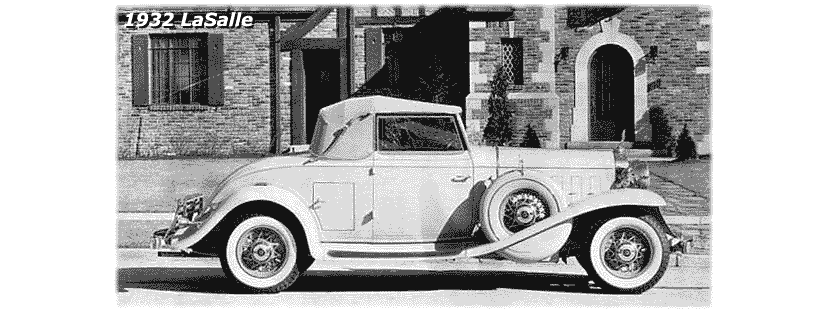
I think the LaSalle automobile was included as a way of force-fitting designer Harly Earl into the narrative and assist with the flow/direction of the author's story.
Ingrassia selects the first Mustang as one of his icons. That makes sense. But his nomination of the Pontiac GTO seems less plausible and simply a vehicle to introduce John DeLorean's story - an artificial construct.
All that said, I actually enjoyed this book. It made me think. And, whether I agree with all of them or not, the author worked hard to justify his selections and provided seemingly appropriate historical and cultural references. How can you not like Bluto, especially Paul 'Bluto' Ingrassia who once won a Pulitzer Prize?
Sum-up: Fun to read but factually sloppy. Recommended with reservations. (posted 10/8/12, permalink)
'Final Victory: FDR's Extraordinary World War II Presidential Campaign' by Stanley Weintraub
This book details Franklin Roosevelt's last campaign for an unprecedented fourth term as president. Roosevelt used his savvy and cunning to charm reporters and other politicians to support him despite concerns about his policies and his obviously failing health. In those days, news came from radio, magazines and newspapers. The press deliberately and/or by omission covered up the president's obvious illness.
In addition to polio and its side effects, the president suffered from persistent, dangerously-high blood pressure, with readings sometimes hitting 180/100. Ross McIntyre, Roosevelt's White House physician, had not checked Franklin's blood pressure in four years. Outside doctors were called in for limited consults and no single doctor was permitted to give the president a thorough physical exam. He had suffered at least one major heart attack hours before a speech in California. In addition, FDR was suffering from congestive heart failure, with fluid accumulating in his lungs. Finally, at the insistence of a Bethesda specialist, McIntyre put Roosevelt on digitalis and, when needed, nitroglycerine. For his blood pressure, it was suggested that the president cut back on his smoking and drinking.
Roosevelt was a heavy Camel smoker and loved his cocktails. His hands shook so badly that he "put more cream in the saucer than in his coffee cup" according to one source in the book. In many ways, this was a medical version of 'Don't Ask; Don't Tell'. FDR had no interest in the precariousness of his health and did his doctors never told him anything directly about his medical condition.
While not discussed in this book, contemporary physicians have speculated that the president had melanoma that started with a lesion above FDR's left eye - removed in 1940 or so - but eventually spread to his brain and abdomen. This is an explanation for the serious weight loss observed in period photographs, which were not widely published at the time. Roosevelt had numerous episodes of severe abdominal pain during the last year of his life, lending additional credence to the digestive system cancer theory. His rambling speeches and difficulty in reading text support the brain cancer thesis.
Shortly before the 1944 election, Winston Churchill's physician wrote in his diary, "To a doctor's eye, the President appears a sick man. He has all the symptoms of the hardening arteries of the brain in an advanced stage, so that I give him only a few months to live." After securing his fourth term in November '44, Roosevelt died of a massive stroke in April 1945.
After Roosevelt's death, his medical files disappeared. People have speculated that Dr. McIntyre destroyed them.
This book was made more interesting with the inclusion of many tidbits. I'll post two of them:
• Sewell Avery, head of mail-order giant, Montgomery Ward was no fan of Roosevelt or labor unions. When employees went on strike, he refused to bargain. The Roosevelt administration had soldiers physically remove "the stubborn and sullen Avery from his office, carrying him out to the delight of waiting news photographers."
• President Roosevelt traveled cross-country and back by train. "Behind the locomotive was an oversize baggage car once owned by the Barnum and Bailey Circus. It had been retrofitted for the President and his Secret Service to hold four automobiles - two sedans and two convertibles."
Weintraub's book seems well-researched and is engaging as well as interesting. I enjoyed reading it. Recommended. (posted 10/4/12, permalink)
'The Great Destroyer: Barack Obama's War on the Republic' by David Limbaugh
This book picks up where Limbaugh's previous book, 'Crimes Against Liberty', left off, chronicling President Obama's record since mid-2010. It's not pretty.
Limbaugh wrote, "In wholesale breach of his 2008 campaign themes, he is zapping America of its optimism and hope, replacing those with despair and malaise. He is using his bully pulpit to turn the American dream on its head, demonizing success and glorifying government dependency."
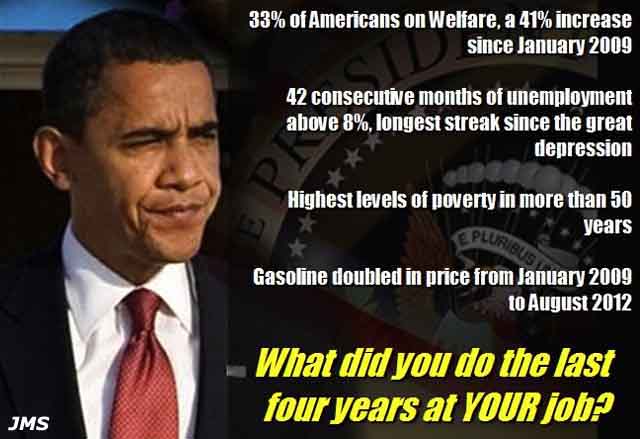
The book is a detailed, well-researched indictment of the Obama Presidency - and it's not over yet! It offers charts, graphs and a dump truck load of footnotes to back up every accusation.
The author wields a harsh and masterful pen, observing that "the Obama administration has waged a relentless, nearly four-year-long war to transform our nation into a country where federal bureaucrats have more power over our lives than we do; where leftist crony capitalism dependent on government subsidies is replacing the real thing; where, in an Orwellian inversion of meaning, a savagely weakened national defense somehow makes us stronger and trillions in deficit spending on counterproductive government 'stimulus' and welfare programs somehow makes us richer."
This is a scary read. If you are considering the gift of a second term to President Obama, you owe it to yourself and your country to read Limbaugh's book first. (posted 9/28/12, permalink)
'The Politically Incorrect Guide to the Presidents' by Steven F. Hayward
Regnery Publishing has offered almost two dozen books in its Politically Incorrect Guide series. The latest is a guide to U.S. Presidents from Wilson to Obama. Historian and Reagan biographer Steven Hayward rates a century's worth of Chief Executives based on their performance in upholding the U.S. Constitution.
This is a easy read that thoroughly addresses its subject. I learned/relearned several things about our presidents:
• Progressive hero Woodrow Wilson screened the pro–Ku Klux Klan movie, 'Birth of a Nation' at the White House. His contemporaries found him to be a nasty, disagreeable man.
• Wilson & Obama were the only two presidents who had been college professors.
• Warren G. Harding saved the U.S. Constitution, which was moldering at the State Department due to improper storage. Harding ordered it restored and placed in a protective glass case.
• Calvin Coolidge was the last president to write his own speeches and was born on the Fourth of July. Silent Cal famously said, "I want the people of America to be able to work less for the government and more for themselves." And: "Don't expect to build up the weak by pulling down the strong."
• Harry Truman was the only 20th Century president without a college degree.
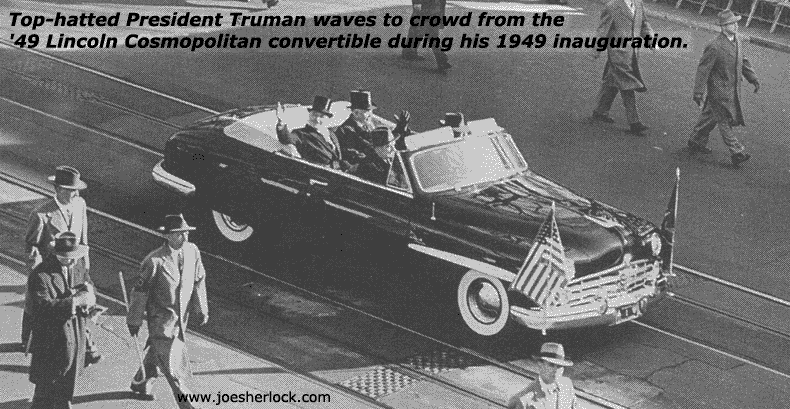
• Eisenhower said that his two biggest mistakes as president "were both sitting on the Supreme Court." He was referring to Earl Warren and William Brennan.
• Federal regulations grew 19% under Lyndon B. Johnson but grew a whopping 121% under Richard M. Nixon.
• Bill Clinton ran a wholesale pardoning operation, especially to Democratic contributors and their relatives. He was the first president to grant clemency to terrorists (members of FALN - violent Puerto Rican Marxists - responsible for more than 130 bombing attacks in the U.S.) and the first to pardon a family member (his half-brother and druggie, Roger, whose Secret Service code name was Headache).
• Barack Obama is described as "the first cigarette smoker in the White House since Lyndon Johnson - though he conceals this fact like much of his record."
Today's presidency has grown far beyond the bounds the Founding Fathers established/envisioned for the office. The inaugural oath's promise to "preserve, protect and defend the Constitution of the United States" has been too often forgotten in a quest for "a new vision," "hope and change" or some other Populist BS slogan.
What you didn't learn in History class you'll find in Mr. Hayward's excellent book. (posted 9/10/12, permalink)
'Trust Me I'm Lying: Confessions of a Media Manipulator' by Ryan Holiday
The author, a self-confessed liar and trickster, discusses the roles of social media and blogging in dispersing information and misinformation. If you've been on the internet for more that three weeks, you've already figured out most of this stuff.
There's no How-To for decent, honest people here. It's a braggart's story about how he tricks people with one-upmanship and lies. In the jacket photo, the author hides his face. Perhaps in shame. Is Ryan Holiday his real name? Who knows?
You can usually find such losers hanging around the bar of your class or fraternity reunion. I was waiting for the Tommy Flanaganesque, "Did I tell you about my wife, Morgan Fairchild?"
Verdict: A waste of time. (posted 9/7/12, permalink)
'A Man And His Ship' by Steven Ujifusa
Once upon a time, ships were the only way to get from North America to Europe. And vise versa. Nations were judged by the kinds of grand passenger flagships they operated. Because of national pride, governments, including the U.S., subsidized prestigious passenger vessels.
We learn much about the passenger ship business in this book. Particularly surprising is the story of Frederick Barrett, one of the few coal stokers who survived the great Titanic disaster. He was rescued, taken to New York and immediately put to work in the boiler room of Titanic's sister ship, the RMS Olympic. No grief counseling or workers' comp was offered in those harsher days of 1912.
America's best naval architect, William Francis Gibbs, was a quirky, cantankerous and brilliant man. He designed some of the finest ships in history. Gibbs also designed and organized production of 70% of the U.S. naval ships in World War II.
His pièce de résistance was the superliner built with leading-edge technology - the SS United States. Its 247,000-plus horsepower could drive it through the water at almost 45 miles an hour. On her maiden voyage in July 1952, United States broke the transatlantic speed record held by Queen Mary for the previous 14 years by over 10 hours, making the crossing from the Ambrose lightship at New York Harbor to Bishop Rock off Cornwall, UK in less than 3.5 days at an average speed of 41 mph.
This book contains four stories - the biography of Gibbs (and, to a lesser extent his brother and business partner), the tale of a great ship: its design, construction, performance, the story of how the rich and famous once traveled in style by sea and eventual downfall of the industry.
The Duke and Duchess of Windsor, the star-crossed and controversial royal couple frequently traveled on the SS United States, reserving the Duck Suite for their voyages. "When the Windsors came aboard, they brought along one hundred and fifty Louis Vuitton steamer trunks and suitcases. ... Stewards replaced United States Lines' linens with Windsor monogrammed Porthault towels and sheets. Standard light bulbs from lamps and ceilings fixtures were replaced with pink-hued ones, presumably because they were kinder to the duchess' complexion. Custom drapes were installed, leopard-skin rugs were thrown on the floor and jewel-encrusted frames placed on the tables. .. Not only that, but their two pug dogs were allowed to romp around the suite during the day." The customer is always right, especially if the are wealthy and influential.
Ultimately, changing technology - jet aircraft - doomed the great ships, including Gibbs' finest, leaving the SS United States a stripped hulk, now berthed on the Delaware River in Philadelphia, awaiting restoration.
Ujifusa's book is well-researched and carefully crafted. Details necessary to understand the significance of SS United States - its advanced development and construction - are provided but the story does not become bogged down in technical minutiae. Recommended. (posted 9/6/12, permalink)
'White House Burning: The Founding Fathers, Our National Debt, and Why It Matters to You' by Simon Johnson and James Kwak
This book begins with an interesting and informative history of the U.S. financial system. The title refers to the fact that British troops invaded Washington in 1814 and set the White House aflame. The financial history of the U.S. was interesting. But the book soon degenerated into a dense screed with a liberal, soak-the-rich, progressive taxation bias and a relatively low concern for a serious reduction of the national debt and control of 'entitlement' spending.
How's Greece working out these days, boys?
My advice: get this book from the library, read the first 50-60 pages, then stop and return it. (posted 9/5/12, permalink)
'Mrs. Kennedy and Me: An Intimate Memoir' by Clint Hill (with Lisa McCubbin)
Clint Hill is the famous, decorated Secret Service Agent who climbed over the trunk of the Presidential Lincoln to protect Jackie Kennedy during the assassination of President Kennedy in Dallas. This book tells of Hill's years working security for Mrs. Kennedy.
It's a sad memoir of a devoted man who neglected his family in order handle the 24/7 duties of the Secret Service. Not much new is revealed here, although I was surprised to learn of the large number of overseas trips undertaken by Jackie. Looking through history's lens, the irony of her trip to cement the friendship with our great ally, Pakistan, now becomes apparent. How times change.
It was also interesting to learn that the Secret Service was often used for babysitting and lowly errand-boy work.
The book's a fast read but, if you're searching for amazing, never-before-revealed revelations about JFK and his family, you'd be advised to look elsewhere. (posted 9/4/12, permalink)
'I Am John Galt' by Donald L. Luskin and Andrew Greta
The premise of this book seems, at first glance, silly: Well-known contemporary icons portray real-life versions of Ayn Rand's fictional characters - heroes and villains. Surprisingly, authors Luskin and Greta do a pretty good job delivering the goods.
Steve Jobs does fit the character of Howard Rourk - a man who invented stuff because it was so cool. As you read the chapter, the authors make a most convincing case that Barney Frank is the evil meddler and government central planner, Wesley Mouch. Except that Frank is perhaps the more sinister of the two.
Angelo Mozilo, the crooked head of Countrywide Financial, fits Rand character James Taggart, the corrupt businessman who nearly wrecked the U.S. economy. Mozilo is described by coauthor Greta as having "a gleaming extra-white Guy Smiley grin," referring to the toothy Sesame Street Muppet who hosts various game shows.
Don Luskin is somewhat puzzled by Alan Greenspan, who - in the late 1990s - appeared to bail on the libertarian laissez faire economic principles he learned as an Ayn Rand acolyte. In his salad days, Greenspan was a genius who, as Fed chairman, successfully steered the economy through rough seas. Luskin offers a graph, showing that Greenspan lost his way around 1997 and was a failed helmsman thereafter. Although it wasn't mentioned in the book, I would note that 1997 was the year he married liberal television reporter Andrea Mitchell. In the book, Greenspan mirrors Robert Stadler, the libertarian character who becomes an economic czar and sellout.
Andrew Greta compares Bill Gates to Rand's Henry Rearden, a successful inventor who was crucified for his success. I'm not convinced on this one. Gates often went way beyond the norm and the law in attempting to crush competitors. I don't see Bill as a prosecuted hero.
Coauthor Luskin takes particular joy in taking down New York Times economist and doomsayer, Paul Krugman, comparing him to Rand's influential socialist Ellsworth Toohey. Krugman once claimed that Luskin was stalking him because Don asked him to sign Krugman's book. At a book signing - can you imagine?!
Bernard Goldberg's 2005 book, '100 People Who Are Screwing Up America,' listed the unpleasant Mr. Krugman as one of the alarming hundred. Krugman believes that Wal-Mart destroys jobs. Jonah Goldberg once remarked, "I could have sworn, reading Paul Krugman, that we were hair's width from a barter economy, where we eat grass and wake up to the sound of "bring out your dead!" every other morning."
It should be noted that, in 1998, Krugman famously predicted, "By 2005 or so, it will become clear that the Internet's impact on the economy has been no greater than the fax machine's."
It is not a prerequisite that one be a Rand expert to enjoy this book. It's been almost 50 years since I read Rand's novels and I had no trouble - the authors explanations are that through. Recommended. (posted 8/31/12, permalink)
'Hollywood Hypocrites' by Jason Mattera
The author attacks the entertainment industry - politically-active actors, directors, producers, musicians and others - who scold us plebeians to increase our socially-consciousness and environmental awareness while they practice quite the opposite. Most of the people mentioned are Friends of Obama. Are you surprised?
The takedowns of the über-annoying Arianna Huffington and the eternally-sanctimonious Bono were especially enjoyable. Sting, Madonna, Al Gore, Alec Baldwin, Matt Damon, Cameron Diaz, Sean Penn, Jane Fonda, Spike Lee, Michael Moore, Bruce Springsteen and various surname-plus-single letter rappers are also excoriated.
I must admit that I was also annoyed by Mattera's writing style. In order to do sarcastic wit and proper snark, one has to be especially talented. P.J. O'Rourke, Mark Steyn and the late Christopher Hitchens were experts at it. Mattera is not - his rapier is a bit dull and his pokes amateurish.
That said, there's good information in the book and it makes for a quick and informative read. (posted 8/29/12, permalink)
'How The Beatles Destroyed Rock 'n' Roll' by Elijah Wald
This is a very good book with a very misleading title. Forget the title; it's just a marketing ploy to help promote the book - something no different than the many marketing schemes cited within this book that helped get dance bands booked or get air time for records.
The subtitle is 'An Alternative History of American Popular Music'. That's a bit off, too. I didn't perceive the contents as 'alternative' but rather a well-though out and documented history of popular music from the 1890s to present day.
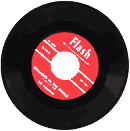 Wald is a folk-blues musician and author of several books on music and musicians. Much of the book is devoted to the origins and influence of jazz and blues on popular music and how various technologies (records, radio, jukeboxes, amplifiers, the development of 45s and LP recordings, television) and events (the revised economics of band-touring caused by the Depression, the shortage of musicians during World War II, various industry strikes and royalty disputes) changed the direction of music in the U.S. Wald is a folk-blues musician and author of several books on music and musicians. Much of the book is devoted to the origins and influence of jazz and blues on popular music and how various technologies (records, radio, jukeboxes, amplifiers, the development of 45s and LP recordings, television) and events (the revised economics of band-touring caused by the Depression, the shortage of musicians during World War II, various industry strikes and royalty disputes) changed the direction of music in the U.S.
The author artfully stitches things together cleverly and interestingly, comparing - for example - Paul Whiteman's musical development to that of Elvis Presley. Who knew that they had so much in common? Unlike some 'purist' articles I've read, the book acknowledges that the Music Biz has always been about money - whether from sheet-music sales, dance-hall revenue or (later) sponsored on-air programs and sales of recorded music. The drive for income influenced the direction of individual performers as well as the music industry itself.
Wald discusses the many manifestations of racial prejudice in the last century of American pop music and how black performers coped with it - and, in many cases, overcame it through talent and ingenuity.
The book's title is ironic because the Beatles didn't destroy rock 'n' roll. Rock evolved or was destroyed, depending on your point of view, by the very nature of the music business. The changes in 20th century music were a combination of evolution (adding string sections to rock and roll recordings, for example, to "class it up" in an attempt to appeal to an older audience) and creative destruction (the never-ending search for something new to entertain a fickle public). Change often came hard - so many musicians lost their jobs when talking pictures eliminated the need for live music in movie theaters, that the American Federation of Musicians took out ads exhorting the public to protest and revolt against "canned" music (described as "tin-clad").
There is little emphasis or discussion of the punk movement and its evolution or of the influence of MTV on the business. Nor is there any mention of the newly-minted stars created by those 'talent' television programs of today. Or YouTube. Nevertheless, I found this book to be readable, entertaining and informative. That's good enough for me. (posted 8/27/12, permalink)
'What The (Bleep) Just Happened?' by Monica Crowley
Monica Crowley is an author, Fox News contributor, nationally-syndicated radio show host and hot-looking blonde. Her fast-paced book answers the question posed in the title, arguing that Barack Obama and his minions are rapidly destroying America and that the country needs a 'Happy Warrior' leader in the mold of Ronald Reagan to save it.
The writing is brisk, often humorous and the subject strongly-argued. Crowley opines that the title question has "been driving us bananas ever since November 4, 2008, when a newly-elected president and Democratic Congress went full-steam ahead with a radical plan to transform the United States into Absurdistan." Some other excerpts:
• During the 2008 election, the Obama brand eclipsed the Clinton brand in most Democratic circles. Obama promised a different kind of politics. "Different for sure: out with the dress stains and in with the Constitution stains," writes Monica.
• The auto bailouts, government interference in the auto industry and kowtowing to the unions makes Monica demand that the vehicles made by the unholy gummint-UAW alliance be identified as such: "I want side-view mirrors shaped like Obama's ears."
• Whole Foods CEO John Mackey characterized his experience with union thuggery thusly, "The union is like having herpes. It doesn't kill you, but it's unpleasant and inconvenient, and it stops a lot of people from becoming your lover."
• Democratic and Congressional Hearings Inquisitor Henry Waxman is described as the "son of Miss Piggy and Torquemada."
• Today's Democrat class warfare agenda is "not about grinding poverty and basic survival. Typical welfare recipients in America now generally receive a cell phone courtesy of the taxpayer lest they be caught in a food stamp emergency without the means to dial 911."
• The Left often claims that the Occupy crowd is no worse than the Tea Party. Monica disproves this nonsense. "The Tea Party pursues its goals within the system by demonstrating peacefully and respectfully. Those attending Tea Parties sang patriotic songs, helped each other out and picked up their litter. The Tea Party uses deodorant. Occupy Wall Street doesn't. The Tea Party helps old ladies across the street. Occupy Wall Street throws old ladies down the stairs. ... The Tea Party likes watching football. Occupy Wall Street likes watching rape."
• Ms. Crowley writes that when Barack Obama was awarded the Peace Prize in 2009, the Nobel Committee "jumped the shark." I think the committee did so long before then.
Dennis Miller reviewed the book and quipped, "Well (bleep) me! What a great (bleeping) book!" While some of Monica's cutesy, humorous comments fell flat, I generally enjoyed the read and also recommend this great (bleeping) book. (posted 8/24/12, permalink)
'The Family Corleone' by Ed Falco
In late 1970, I was stuck at a hotel near Boston's Logan Airport, my last stop before a return flight home the next morning. After dinner, I returned to my room and began reading a paperback, titled 'The Godfather'. I was sucked into the well-told story and stayed up all night, finishing the book just before my 7:00 am flight.
Other Puzo books were good but failed to have the raw impact of his debut novel. Mario Puzo died in 1999, leaving an unfinished screenplay which author Falco fleshed out and presented as 'The Family Corleone'. Set in the period between 1933-35, the story finds Michael, Fredo and Connie in school. Tom Hagen is in college and Sonny is a young, aggressive, impatient and reckless thug, trying to get into his father Vito's family business.
It's a serviceable read but lacks the red-meat passion of 'The Godfather'. (posted 8/22/12, permalink)
'1920: The Year of the Six Presidents' by David Pietrusza
Anything author Pietrusza writes about politics goes on my must-read list. I have previously written favorable reviews of '1948: Harry Truman's Improbable Victory and the Year that Transformed America' and '1960 - LBJ vs. JFK vs. Nixon: The Epic Campaign That Forged Three Presidencies'.
Published in late 2006, this well-paced book chronicles the fight for the 1920 presidency. Six once-and-future presidents plotted and planned to win the White House: Woodrow Wilson, Warren G. Harding, Calvin Coolidge, Franklin Delano Roosevelt, Herbert Hoover, and Theodore Roosevelt. It was the first election to garner extensive newsreel coverage. It was also the first election in which women could vote.
There is much to tell about the campaigns but Pietrusza also relates the culture of the times: post WWI America, the onset of Prohibition and early years of the Jazz Age. Here is a smattering of interesting tidbits from the book:
• In 1918 - at the conclusion of World War I, President Woodrow Wilson decided to travel to Europe to negotiate the peace. He traveled in the 700-foot-long ship, George Washington, escorted by the battleship Pennsylvania and a flotilla of ten destroyers. We complain mightily today about the extravagant cost of Presidential travel but it was no bargain in 1918 either.
• If you think egregious government spending is something new, consider this: During World War I, the Army bought $21 million (about $420 million in today's dollars) worth of ambulance harnesses for horses and then found out that all ambulances were motorized. During the war, the government ordered over 41 million pairs of shoes for only 3,513,837 soldiers.
• Franklin Roosevelt had a summer getaway on Campobello, a Canadian island off Nova Scotia. To get there he, as the Assistant Secretary of the Navy, commandeered a destroyer, the U.S.S. Hatfield to take him there from Boston. The New York Journal questioned "the use of a warship for commuting purposes."
• Wilson fell extremely ill in 1919. While it wasn't revealed to the public at the time, he suffered a massive stroke which left him partially paralyzed and affected his mental abilities. His wife and advisors ran the country, refusing to relinquish power to the vice president.
By today's standards, Wilson was probably too sick to even be president in 1912: "An 1896 stroke had temporarily hampered his control of his right hand. A 1906 stroke had briefly blinded his left eye and permanently robbed him of everything but its peripheral vision."
• About Republican candidate Warren Harding, William Gibbs McAdoo (former U.S. Secretary of the Treasury and Woodrow Wilson's son-in-law) "skewered him thusly: 'His speeches left the impression of an army of pompous phrases moving over the mindscape in search of an idea. Sometimes these meanderings would actually capture a struggling thought and bear it triumphantly, a prisoner in their midst, until it died of servitude and overwork.'"
Progressive Harold Ickes (later Franklin Roosevelt's Secretary of the Interior and Director of the Public Works Administration) called Harding a "platitudinous jellyfish ... a man upon whom the Lord conferred a bunch of wet spaghetti instead of a backbone."
Political sniping was just as nasty back in the "good old days."
• When Calvin Coolidge was elected to the Massachusetts general assembly in 1906, he brought with him a reference from a former state senator: "This will introduce to you the new member-elect from my town, Calvin Coolidge. Like a singed cat, he is better than he looks."
• Following World War I, inflation reared its ugly head. In 1919, it was almost 15%. Nationally, men formed Overall Clubs, wearing denim to protest the high price of clothing. The movement sputtered when demand drove the "price of overalls from $3.10 to $8.00 a pair."
• At the 1920 Republican National Convention, San Francisco attorney Charles Wheeler gave a long and dreary nomination speech for fellow Californian Hiram Johnson. New York Tribune columnist Heywood Broun opined that Wheeler had "made every mistake known to public speaking except that of falling off the platform."
• Republican vice-chairman for publicity in 1920 was Albert Lasker, an adman best known for the Quaker Puffed Wheat and Puffed Rice slogan: 'Shot from Guns'. He also helped promote Lucky Strike cigarettes as a weight-control device for the ladies: 'Reach for a Lucky instead of a Sweet'.
• "Former circus magician Timothy Drew (aka Noble Drew Ali) operated the 'Moorish American Science Temple', with fez-clad disciples ... His movement would become the Nation of Islam."
• Marcus Garvey, a Jamaican immigrant, organized the Universal Negro Improvement Association. Garvey built a business empire including "grocery stores, a steam laundry, a restaurant, a tailor shop, a millinery, a dressmaking shop and even a publishing house. Pride of place belonged to his Black Star Steamship Company."
Unfortunately, on the line's maiden voyage, "the 1,300-ton Yarmouth (renamed the Frederick Douglas) embarked from Brooklyn to Cuba. It carried $4.8 million worth of booze. The crew got drunk, landed at Norfolk and had its cargo seized. The Kanawha, carrying $2 million worth of whiskey, fared worse, ramming a pier at Norfolk and exploding its boiler."
Black Star went out of business in 1922.
• Until 1960, Maine held its state and local elections in mid-September, far earlier than other states. Pundits looked to main results to get some idea of the national sentiment, leading to the old adage, "As Maine goes, so goes the nation."
In those days before there were national polling organizations, customers at the 8,000-store Rexall Drug chain "deposited ballots in in-store ballot boxes overseen by specially hired clerks." Rexall polls turned out to be a pretty good predictor back in the day, forecasting the Harding landslide victory in 1920.
• Oklahoma oilman Jake L. Hamon was in line to be Harding's Secretary of the Interior. Hamon's private life was described by the author as "lively." "Hamon had taken up with redheaded Clara Barton Smith. He appointed Clara his secretary, married her off to his nephew, Frank Hamon, and then dispatched Frank to the West Coast, leaving Jake and Clara to live blissfully as man and niece."
Harding ordered Hamon to dump Clara if he wanted a role in Washington. At dinner, a feisty Clara - "angry at the thought of being jettisoned - threw a duck in Hamon's face. They argued in their rooms. If Hamon abandoned her, Clara wanted cash. Hamon struck her with a chair. Clara shot him and four days later, he died."
Clara ran off to Mexico but was arrested was put on trial but, after only 39 minutes of deliberation, the jury found her not guilty.
This book is not mere history; Pietrusza has brought 1920 to life and created a compelling page turner. I highly recommend it. (posted 8/20/12, permalink)
'Ayn Rand Nation: The Hidden Struggle for America's Soul' by Gary Weiss
Everybody over the age of 30 knows that, while Ayn Rand's novels inspired people to become self-sufficient and, in some ways, led to a resurgence of political conservatism, Rand herself was a flawed individual. She was a libertarian-to-the max and a fierce advocate of unfettered laissez faire capitalism. An idealist, Ayn Rand often rejected conservative politicians.
Flawed also is Weiss' book. He focuses on Rand's imperfections especially that Rand, a Jew turned atheist, has failed to live up to his own Jewish expectations. And she has pissed him off in other ways. I found the 'Hidden Struggle' to be less about Rand than about Weiss and his own internal rage, personal issues and his attempts to connect dots where there are none.
This is neither a biography, nor objective nonfiction. It is a mean-spirited and wildly misinformed diatribe against Rand, her followers, admirers and the Tea Party. And Alan Greenspan.
Weiss' targets include conservative blogger Pamela Geller. In trying to tear her down, he quotes from Little Green Footballs, a once-good conservative/libertarian blog which has descended into lunacy and irrelevance. LGF has lost a lot of readers and is no longer considered to be a credible source by most conservative bloggers.
He tries to demonize John A. Allison IV, former head of successful regional bank Branch Banking & Trust. In 2008, Allison was nominated by Morningstar as one of the best CEOs. Angered by the government's attempt to cram unneeded TARP funds down his successful bank's throat, Allison walked away, retiring at the end of 2008 as CEO of BB&T. Weiss considers this to be a bad thing somehow. On the other hand, author and investment guru Don Luskin sees Allison as a hero - a modern-day John Galt.
Both Ms. Geller and Mr. Allison agreed to be interviewed by Weiss. Their responses to his questions seem honest and forthright. Until Weiss "interprets" them and adds 'scary' nuances, much like holding a flashlight beneath someone's chin and finding frightening facial shadows.
Using the liberal smear 'teabagger' (a lefty reference to a certain homosexual act), he wrongly derides Tea Party members as Rand acolytes, even though most members of the less-government group have only a passing acquaintance with Ms. Rand's philosophy. Weiss also blames the 2008 U.S. financial meltdown on Ayn Rand, who had been dead for over 25 years. Go figure.
This book is a waste of time, ink and paper. It is choleric, sophomoric and undeserving of your attention. (posted 8/17/12, permalink)
'100 Things Every Designer Needs To Know About People' by Susan M. Weinschenk, Ph.D.
To begin with, there's a lot of semi-annoying, distracting pop psychology in this book. I expected to learn about designing in different arenas, applications and media. Instead, I found two stories about door-opening devices; the remaining examples were about print and web design.
Ninety of the things listed are of zero-to-marginal interest to designers. The other ten are intuitive. One of the ideas presented was: On web pages, it's best to use black text on a white background for readability. Well, duh.
This otiose pile-o-pulp taught me nothing. It was a colossal waste of time. (posted 8/15/12, permalink)
'Abundance - the Future is Better Than You Think' by Peter Diamandis and Steven Kotler
There is a tendency among all of us to be pessimists. We worry about the future because it is an unknown. We are concerned for our children's and grandchildren's future. We have seen entropy first hand and know that downward trajectories are natural phenomena. People get old, frail and sickly. Wood rots. Plastic embrittles, crazes and discolors. Steel rusts. Buildings and bridges crumble. The Roman Empire fell. We eventually return to dust.
|
|
The future as envisioned by Firestone in 1945. A land of blue skies, personal helicopters, streamlined trucks and teardrop-shaped cars passing art deco buildings at 120 mph.
|
Those of us of a certain age were once told of a wonderful future that never came about - a nation of monorails and flying cars, smoking Lucky Strikes outside a cafe on Mars, elevators to the moon, a pill which fixed all ailments and underwater cities enclosed in giant Plexiglas domes.
The authors of 'Abundance' offer a bright future, extrapolating current technological developments to improve everything and bring prosperity to all peoples and nations. They examine human desires/needs by category: water, food, energy, healthcare, education and freedom.
Consider this: "Over the past 20 years, wireless technologies and the Internet have become ubiquitous, affordable and available to almost everyone. Africa skipped a technological generation, by-passing the landlines that stripe our Western skies for the wireless way."
In Kenya, a job-placement service uses mobile phones "to connect potential workers with potential employers. ... In Zambia, farmers without bank accounts now rely on mobile phones to buy seeds and fertilizer, boosting their profits by almost 20%."
On the surface, this book is a good read which will make a optimist out of you. How can you not be happy when accomplished neurotrama surgeon Robert Hariri predicts a wonderful and exciting future for medicine? He has said, "In the next five to ten years. We're going to be able to use stem cells to correct chronic autoimmune diseases such as rheumatoid arthritis, multiple sclerosis, ulcerative colitis, Crohn's disease and scleroderma."
Soon after that, Dr. Hariri believes that "we'll reverse the effects of Parkinson's disease, Alzheimer's disease, even stroke." Not merely for the wealthy but for everyone because the treatments will soon cost "less than the price of a new laptop."
I hope he's right. But many of the ideas discussed in the book are presented without considering the problems of application for these whiz-bang technologies: funding, cost, cultural difficulties, legal impediments and political roadblocks. There is also a leftist, utopian tone to the book, which some readers will find off-putting. Given the poor track record to date, it is questionable whether things like the authors' proposed solar and algae solutions to the world's energy problems will ever be anything but fringe answers.
It is ironic that this book has almost 50 pages of black & white charts and graphs, many of which are quite difficult to read because of the minute differences in grayscaling - a problem solved by printers 75 years ago when Zipitone in its many forms came into use. Ironic too is that this 'futuristic' book is not presently available for Kindle or other e-book readers.
Author, inventor and futurist Arthur C. Clarke published 'Profiles of the Future' in 1962. It seemed similarly 'far out' when I first read it in college. But some of Clarke's seemingly outrageous predictions really did come true. Let's hope that the best of Diamandis' and Kotler's forecasts become reality as well. (posted 8/13/12, permalink)
'Defending The Free Market' by Rev. Robert Sirico
Over the years, I've sat in many a pew listening to priests try to interpret Jesus' words, "It is easier for a camel to go through the eye of a needle than for a rich man to enter the kingdom of God." I've yet to hear a cogent explanation from the pulpit.
If all those now-deceased successful entrepreneurs have gone to Hell because they've made lots of money on earth, I would think that they'd have used their skills to turn Hades into a five-star destination. Kinda like a Four Seasons resort but a little hotter. Maybe if you've become Really wealthy on earth, you'll be upgraded (or is it 'downgraded') to Concierge Level. And, with Steve Jobs down there, you'll have some awesome electronic devices - not to mention a devilishly-fast internet connection. Perhaps the 'hell' part of Hell is having to teach Attila the Hun to use a computer: "Owwww! Quit clubbing me, dammit! Just hit the F7 key."
I'm always amused when - after the camel/needle's eye homily - the next worlds seem to be, "Please be generous during our weekly collection which begins right now." There's a sort-of ironic 'money is evil but give us your money anyway' vibe.
When you look at ... (more >>>)
'Atlantic Fever: Lindbergh, His Competitors, and the Race to Cross the Atlantic' by Joe Jackson
We have become such a sound-bite nation these days that we few details beyond headlines. Ask most people about early aviation history and you'll hear about 'Lucky' Lindbergh flying ... ummm ... somewhere. If you're fortunate, the respondent may remember that his airplane was the 'Spirit of St. Louis' and it is now on display at the Smithsonian. If you meet a so-called history buff, he/she may be able to tell you about Richard E. Byrd, who claimed to be the first man to reach the North Pole by air in 1926.
Ah, but there's so much more to the aviator madness that were part of the Jazz Age and Roaring Twenties. Jackson's fine book reveals the tales, the personalities and the struggles during those early flying days, as fourteen aviators took to the air to capture the $25,000 prize that Raymond Orteig - a New York City hotel owner - offered to the first person to cross the Atlantic Ocean without stopping.
The fact that Charles Lindbergh made the first solo nonstop flight across the Atlantic Ocean late May 1927, landing at an airfield in Paris in his single engine aircraft, is only one part of the story.
Author Jackson does a fine job of painting interesting portraits of the personalities and their compelling stories while immersing the reader in the era's public excitement about flying - something hard to imagine in today's hum-drum Airbus era.
We learn that all is not as it seems. Admiral Byrd's 1926 flight may never have reached the North Pole in 1926. Byrd knew it and was haunted by it. There was a great deal of infighting among the various players, aviators, backers and the press. There are stories within stories and period tidbits which will keep readers engrossed. I learned many things, including:
• The concept of rapid travel across the Atlantic was not well understood. In 1894, a book carried an illustration of "a steam locomotive crossing the ocean on a train track suspended from hot air balloons." Actually, my grandmother's 1926 edition of The Book of Knowledge, a 20 volume illustrated encyclopedia, contained a drawing showing passenger trains departing earth with tracks heading to various planets. The travel time was given for each heavenly body based on a steam locomotive speed of 60 mph.
• While the book is primarily about the air race, glimpses into the events of the time are offered. In August 1926, silent movie idol Rudolph Valentino died in New York City. The author noted that this caused "the first celebrity-inspired riot in the city's history - when Valentino's body was laid out in an ornate silver-bronze coffin displayed behind the huge plate glass windows of mortician Frank E. Campbell's funeral home. Thirty thousand mourners lined the street. When they pressed against the window glass, it shattered and mounted police charged the mod in an attempt to drive them away. Instead, the mourners rubbed soap on the street so the horses would slip and fall." What kind of mourners bring soap to a wake?
• WWI flying ace Eddie Rickenbacker was a passenger aboard a plane piloted by prize-seeker Harold Hartney. Hartley was prone to accidents and, in Omaha Nebraska, his plane crashed into an empty house during a failed takeoff attempt. Rickenbacker reported that the only injury was "a severely fractured straw hat."
• In 1878, John Wanamaker introduced the concept of the White Sale to combat seasonal sluggishness at his department store. His son, Rodman, sponsored one of the teams trying to fly across the Atlantic - headed by Richard E. Byrd.
 • Another prize-seeker, renowned French ace pilot and adventurer, Charles Nungesser, is best remembered as a rival of Lindbergh. He was briefly married to an interesting woman, Consuelo Hatmaker, a wealthy and comely Manhattan socialite 10 years his junior. Consuelo and Charles remained friends after the divorce and there was talk of a reconciliation after the flight. • Another prize-seeker, renowned French ace pilot and adventurer, Charles Nungesser, is best remembered as a rival of Lindbergh. He was briefly married to an interesting woman, Consuelo Hatmaker, a wealthy and comely Manhattan socialite 10 years his junior. Consuelo and Charles remained friends after the divorce and there was talk of a reconciliation after the flight.
After the divorce, Consuelo lived in Philadelphia but returned to Paris to see Charles before he left on his attempt to make the first non-stop transatlantic flight from Paris to New York, flying with wartime comrade François Coli in The White Bird. Consuelo promised to meet him when he landed in New York.
Unfortunately, the plane was lost at sea in May 1927. The author presents compelling evidence that Nungesser's craft performed well but the author believes that it was shot out of the sky by rum runners on the speedboat Amistad, who thought it was a U.S. Treasury plane looking for illegal hooch haulers.
Consuelo later traveled to India and fell under the spell of Meher Baba, an Indian guru known for his mantra: 'Don't worry, be happy.' Later, she lived in an apartment overlooking the Seine and, in 1934, married Parisian art dealer Alfredo Sides. Consuelo died in 1966 and is entombed in her stepfather's mausoleum in New York.
• Prize-seeker Clarence Chamberlin and his wife Wilma ran out of fuel - due to a leak from a loose gas cap - on the way to an air meet in Camden NJ. "Chamberlin banked sharply, crested a stone wall and landed. It turned out they had set down in a potato patch inside the walls of Philadelphia's Eastern State Penitentiary. A group of convicts walked up followed by three or four guards with guns." Wilma was quite upset - the landing made her ill and she had to "lie down and rest in the jail."
|
|
Established in 1829, the Eastern State Penitentiary, located in Philadelphia's Fairmount section, has become a tourist attraction because mobster Al Capone and bank robber Willie Sutton were once guests there. It's considered to be the world's first true penitentiary.
|
• Keystone Aircraft Company, an early pioneer in airplane manufacturing, had a 200,000 square foot plant in the sleepy little river town of Bristol, Pennsylvania. (I worked in the burg for five years - at Rohm & Haas' Plastics Engineering Lab - and had no idea such a large aircraft firm once existed there.) The company built a Pathfinder tri-motor airplane, christened the American Legion, for Noel Davis, a former Navy pilot. He and copilot Stanton Wooster were killed when the heavy plane crashed on takeoff in April 1927.
I highly recommend this informative and interesting book. (posted 7/31/12, permalink)
'Freedom's Forge: How American Business Produced Victory in World War II' by Arthur Herman
If you've ever wondered how the United States converted from a moribund consumer economy to the booming arsenal of World War II, this is the book to read. Arthur Herman tells the story in an engaging and exciting fashion, creating a genuine page-turner.
Inside are the untold stories of industrial miracles, many of them made possible by Bill Knudsen and Henry J. Kaiser, two business titans of the period. Dubbed the 'dollar-a-year men', these two, along with other dedicated patriots, quickly took charge of America's lackluster war production effort.
Details about how America financed this great undertaking are also revealed as well as the stories of FDR's flaws and foibles mixed with his good decisions. Readers also learn about the socialist New Dealers mistrust of business and how that undermined the efforts of industrialists to ramp up war machinery production.
Profiles of small businesses which proved vital to the war effort are presented. Here's one: "Ma and Pa Harrington's 'defense plant', for example, was a white clapboard farmhouse ... near Rockford, Illinois. There they made machine tools for turning artillery shells and tank turrets, one thousand dollars a month's worth right in their living room." When the family concern found out that their main toolmaking machine was priced at $4,000, "they made their own out of a junked lathe, an old washing machine motor and an oil pump salvaged from a 1926 Chevrolet."
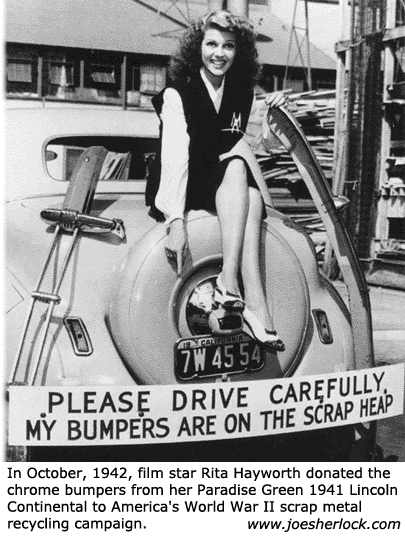
There were many examples of companies that played a significant role during the Second World War. To properly tell the story of all, a 50 volume encyclopedia would be required - something obviously beyond the scope of this book. I can think of three examples:
• During the war, most toy production ceased, except for wooden and paper toys. In 1941, plastic was in it infancy and was not used for many toys. Most were made from stamped lithographed tin, die cast zinc or molded rubber. Toymakers found themselves making military components during WWII. Lionel, the largest maker of electric toy trains, suspended electric train production in June 1942 and devoted its energies to the production of compasses, binnacles, peloruses, compass cases and antiaircraft shell percussion primers for the war.
• Invented in 1936, Plexiglas acrylic sheet was a new product with few uses before the war. It was found to be ideal for aircraft canopies. Rohm & Haas, its inventor, produced thousands of canopies at its Bristol, Pennsylvania plant during the war. The early grades of acrylic were difficult to form and the conventional air blow method (like making bubbles with bubble gum) couldn't be used. Instead, a differential pressure system using heated oil was employed. Because early versions of acrylic were chemically attacked by many kinds of heated oils, whale oil was found to be the safest choice. Lots of whales gave their lives to make the acrylic turrets and canopies that helped America win the air war.
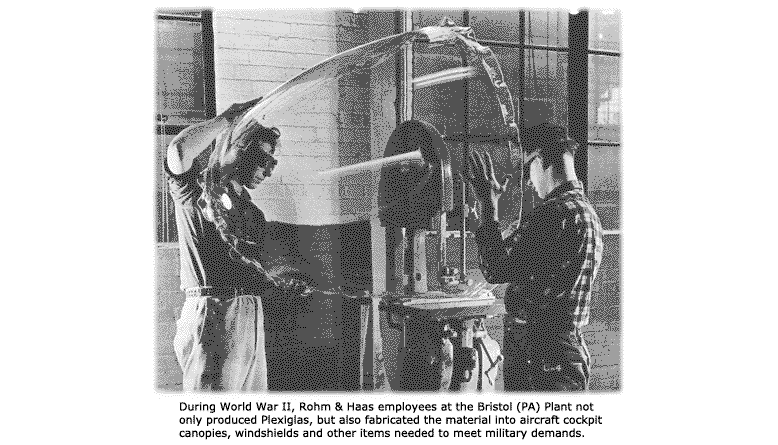
DuPont also produced Lucite acrylic canopies in Delaware during the same period.
• Cincinnati Milling Machine, a tool building firm founded in 1899, produced many of machine tools used by other manufacturers during WWII including a huge machine for boring giant naval guns. During World War II, the company experienced a sevenfold increase in production and built 17,511 machine tools in 1941 - 7.8% of the nation's total machine tool production. The new techniques for producing accurate, large-bore barrels helped Cincinnati move into making plastic extruders and injection molding machines after the war.
Social changes brought about by the war are also chronicled. When Consolidated-Vultee aircraft plant decided to hire women, the 25 female employees "were put to work in the electrical subassembly plant a day later than planned." Management feared that if they started on their originally scheduled day, April 1, "everyone would think it was an April Fools joke." By July 1944, 36% of all workers at prime defense contractors were female. Herman relates the story of Helen Dorch Longstreet, a riveter at the Marietta Georgia Bell aircraft assembly plant, who was the widow of Confederate general James Longstreet. Ms. Longstreet was 80 when she started at Bell. She drove to work every day in her Nash coupe. An energetic woman, she ran unsuccessfully for governor in 1950. She died in 1962 at age 99.
I hope that someday, author Herman or someone of his talent writes a book about the transition from the war economy to a civilian one in the post-WWII period. I would be interested in how cathode-ray tube technology used in military radar helped television makers as well as more details on the postwar automobile market. Originally, auto manufacturers were planning small cars for the postwar market, fearing that the cost of the war would result in a very sour postwar economy. That, of course, turned out to be quite wrong.
In four short years, America's movers and shakers transformed America's military hardware from almost nonexistent into a global powerhouse and laid the foundation for a mighty postwar industrial America which became an economic as well as military superpower. 'Freedom's Forge' chronicles how it was done. Recommended. (posted 7/23/12, permalink)
'Screwed!: How Foreign Countries Are Ripping America Off and Plundering Our Economy - and How Our Leaders Help Them Do It' by Dick Morris and Eileen McGann
The husband and wife team have written a blistering exposé of how America is being robbed and conned by friends and enemies alike - with aid from elected politicians. The ruling elite encourages jobs being exported. U.S. foreign aid funds our enemies. The UN is drowning in corruption yet we still contribute billions to it.
Authors Morris and McGann have given me a sobering education.
Be sure to read section on China. The authors point out the folly of letting China into the World Trade Organization. "Twenty years ago, (China) ran a measly $10 billion trade surplus with the United States. Ten years ago, it was only $83 billion. Now, it is over $300 billion." The section on Pakistan will make your blood boil.
The section on U.S. foreign aid was familiar territory for me (and probably many others) but I was astounded at the degree of ineffectiveness and mismanagement at the World Bank.
I was pleasantly surprised to learn about the success of little-known Overseas Private Investment Corporation, "a U.S. government agency that promotes private investment in other countries to help them develop and encourage them to buy American products and services, creating jobs in the United States as well." OPIC finances its operations by "charging market rates for its services and capital ... OPIC has generated $74 billion in U.S. exports and claims to support 274,000 American jobs in the process."
The chapter on Venezuela and its spreading of terrorist activities to other South American countries as well as its ties to Iran was disturbing eye-opener. Who knew the extent of evil in our Western hemisphere? Yet, last week, President Obama said that he does not see Venezuela as a threat to U.S. Read the book and you'll feel quite differently about the Menace from South America than our clueless leader.
'Screwed!' is not without shortcomings. The authors don't seem to understand the differences between a hybrid vehicle, a plug-in hybrid and an all-electric vehicle. They are supporters of ever-increasing CAFE numbers for future vehicles - something I'm against. The book carried numerous editorial cartoon-style illustrations by the apparently-talentless Clayton Liotta. I've seen better drawings from nine year-olds.
Criticisms aside, this book is full of important facts, lessons and recommendations and should be read by every citizen who is concerned about the direction of our country. (posted 7/17/12, permalink)
'Not Taco Bell Material' by Adam Carolla
I first became aware of Adam Carolla when he was the cohost of the late, great 'The Man Show'. I really enjoyed Adam's last book, 'In Fifty Years, We'll All Be Chicks', published in 2011.
In that book, Adam used his observational abilities and caustic wit, to take on ordinary, everyday things such as tampon strings, bottled water served in restaurants, ketchup packets, back-up beepers and more. It was an easy - and very funny - read.
In his latest endeavor, Carolla does more funny angry middle-aged man rants. I enjoyed parts of it and laughed out loud several times as Carolla told stories about everything from the bad jobs he's had, the dumpy flophouses he's lived in, issues with his loser family, his '64 Caddy 75 limousine, home remodeling stories and tales of encounters with stars - escorting Natalie Maines of the Dixie Chicks to an award show for example.
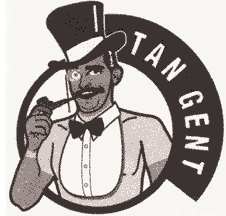 Since he sometimes rambles, he provides a humorous icon, Tan Gent, to indicate that he's about to go off in the weeds. Since he sometimes rambles, he provides a humorous icon, Tan Gent, to indicate that he's about to go off in the weeds.
I felt almost like I was almost part of the book when Adam mentioned Cook E. Jarr and the Krums, a Las Vegas lounge fixture since the early 1980's.
In 1975, my soon-to-be business partner and I were in Miami Beach for a trade convention. We were bored stiff after a day of making nice to people a generation older than us and were anxious to blow off steam. That evening, we ended up in a loud bar, knocking back many scotches and cheering on Mr. Jarr and his Krums as they performed cover songs loudly and energetically. In the '70s, the band worked gigs up and down the East Coast.
Adam wrote of Cook E., "He had hair like Cher from the seventies and you couldn't tell if he was a light-skinned black guy or a dark-skinned douchebag."
Unfortunately, 'Not Taco Bell Material' is disappointing compared to Carolla's first book. Some of the stories are too familiar - they are simply rehashed from the previous work. There are far too many stories about gross pranks involving bodily functions, too many fart jokes and reprehensible conduct, such as the time Adam amused his friends by grossing out Tom Cruise and Cruise's aging mother.
There was, in my opinion, too much detail about the unfunny antics of his family. I already knew enough details of his unfortunate childhood from his first book. I didn't need more.
You should also know that the latest book is an "as told to" version; 'In Fifty Years ...' was written by Carolla himself. Adam writes better than his ghostwriter.
While a lesser endeavor, 'Not Taco Bell Material' is a fairly-decent read overall. (posted 7/9/12, permalink)
'The End Of Money' by David Wolman
This book is a mixture of ruminations about money, the history of coinage and paper currency and observations/predictions about the coming cashless society. Woven into the book are the author's experiences as he decides to shun cash for an entire year.
I found it to be entertaining but not very deep - perhaps it wasn't supposed to be. The book was somewhat informative but, in the end, left me with as many questions as answers. Maybe that's why it was fairly thin - just over 200 pages sans index and notes. (posted 7/3/12, permalink)
'The Amateur: Barack Obama in the White House' by Edward Klein
The prologue of this book opens with the Clintons. Klein began with these opening words, "Bill and Hillary were going at it again, fighting tooth and nail over their favorite subject: themselves." Bill Clinton was so disgusted with Obama that he wanted Hillary to challenge him in the 2012 Democratic primary.' Clinton referred to the sitting president as 'amateur' - hence, the title of Klein's book.
Klein is no conservative icon - his resume included contributing editor to Vanity Fair, former foreign editor of Newsweek, and former editor-in-chief of the New York Times Magazine, mostly liberal publications. Nevertheless, his book tears apart the carefully-crafted faux image of Barack Hussein Obama and reveals the shallow, seedy, phony interior of the man.
Edward Klein reveals never-before-published unflattering details about the Obama administration's political inner workings, as well as Barack and Michelle's personal lives. Barry's afraid of his wife, by the way. After reading this book, I can't say I blame him. NY Post writer Andrea Tantaros has described Michelle as 'a modern-day Marie Antoinette', "the French queen who spent extravagantly on clothes and jewels without a thought for her subjects' plight."
While much of the country is pinching pennies, scaling back or eliminating vacations and/or trying to find/keep a job, the Obamas are acting like 1960s jet setters, taking frequent and extravagant trips to desirable spots worldwide.
Author Klein carefully documents the performance failures of the administration and how Obama's bad decisions, bad staff selections and failure to delegate has left the president with a host of angry former cheerleaders including Oprah, the Kennedy clan, the Clintons and other powerful Democrats. And Catholics. All the while blaming Bush and Republicans for the Obama administration's shortcomings.

On page 233, Klein provides six reasons why Obama is much like Richard Nixon - in temperament, divisiveness and peevishness. Barry O. believes that he and only he, knows the answers to all the questions and often treats advisors and colleagues with disdain. You may recall the July 2011 incident when Obama abruptly walked out of the White House debt talks after warning House Majority Leader Eric Cantor, "Don't call my bluff."
As to his failures: Remember when Obama and Biden declared that mid 2010 would be the Recovery Summer? Didn't happen, did it? It turned out to be more like the 1997 Seinfeld episode, the 'Summer of George', initially described by George Costanza as "time to taste the fruits and let the juices drip down my chin."
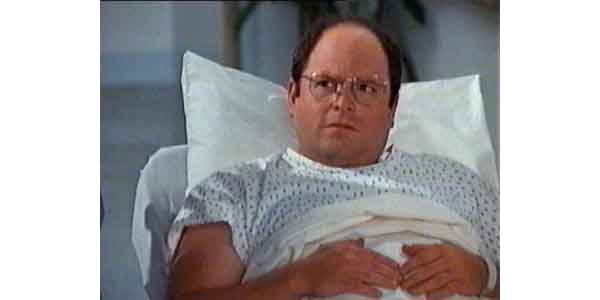
Just as things didn't work out so well for Mr. Costanza, Messrs. Obama and Biden learned that the economy's legs "have sustained extensive trauma. Apparently your body was in a state of advanced atrophy, due to a period of extreme inactivity and abuse. But with a lot of hard work and a little bit of luck, I think there's a good chance you may, one day, walk again."
This extremely well-written and apparently well-sourced book presents a clear picture of Obama as the second coming of Jimmy Carter. Or Woodrow Wilson.
As someone who reads a lot of conservative blogs and news sites and has previously expressed strong and negative opinions about this president, I thought I had heard pretty-much everything about Barack Obama. Not so. This exceptional book has really opened my eyes. It's a must read. (posted 6/27/12, permalink)
 'American Grace: How Religion Divides and Unites Us' by Robert Putnam and David Campbell 'American Grace: How Religion Divides and Unites Us' by Robert Putnam and David Campbell
The content of this book is based on two comprehensive religious surveys conducted by the authors. It contains a great deal of information in its almost 700 pages. The problem is that it reads like a doctoral thesis. It is full of statistics which are presented in a dry, often mind-numbing manner.
After the 50th time the authors wrote "in our next chapter ...", I was ready to scream. The book is packed with graphs; many of them are grayscale bar graphs - with four or five shades of gray - that are annoyingly hard to read.
In many cases, there is insufficient interpretation and analysis of information presented. For example, the authors have chosen to split Catholics into two groups: Anglo Catholics, a declining base within the Church (they're dying off) and Latino Catholics (growing due to large families and immigration).
References are made to the struggle that Catholic parishes are having in recent years and it is pointed out that Latinos won't volunteer to help out with parish duties/activities the way Anglos do/did. Based on discussions I've had with various parishioners in parishes throughout the U.S., 'Latinos' is too broad a classification. For example, Cuban immigrants are and have been great supporters of parishes, both financially and volunteer-wise.
On the other hand, Mexicans fail to provide much in the way of volunteers or money. The authors make no reference to the parish financial difficulties caused when the mix changes from Anglo to Mexican. One usher I spoke to characterized the difference as "twenties versus dollar bills."
I did learn things from this book: the impact of megachurches and an understanding of the people who attend them as well as a better understanding of the Mormon faith. But 'American Grace' made it a struggle to read and learn rather than the easy task that a better written and edited book would have made. (posted 6/21/12, permalink)
'Coming Apart: The State of White America, 1960-2010' by Charles Murray
Having read and enjoyed Murray's controversial book 'The Bell Curve' when it came out in 1994, I was anxious to read his latest work. I wasn't disappointed.
In Coming Apart, Charles Murray demonstrates that, over the last 50 years, upper class and lower class values and character have diverged greatly. The classes barely interact anymore. This change has been happening at a fairly steady pace and has little to do with income inequality or the economic cycle.
Murray begins the first chapter with a recounting of the 'good old days' and how America has changed, presented in a believable way. In subsequent chapters, he demonstrates that the top and bottom classes of white America now live in vastly different cultures/environments. The rich now live in enclaves surrounded by their equals, ignorant about life in lower-class neighborhoods. Meanwhile, the lower class have lost the inspirational effect of living among their social betters and experience erosion of values: work, faith, community and family.
The author Murray supports each of his claims with data; the book is chock full of charts and graphs with additional supporting material in the notes and appendix. Two of the graphs jumped out at me:

The above graph illustrates the relative increase of people receiving disability benefits, a rise Murray calls "unbelievable." He notes that, "Until recently, healthy men in the prime of life who did not work were scorned as bums. ... The norm has softened." The percentage of workers who are actually disabled should be in decline. Murray cites medical and technological advances over the last 50 years. I would add that OSHA has made the workplace safer, too. Yet the percentage of people qualifying for disability benefits has risen over sevenfold over the last half-century. Smells like fraud to me - classical soft tissue or nerve injury claims (backs, knees, carpal tunnel, etc.) are hard to diagnose as real or faked. Murray offers this graph as a proof in the decline of personal industriousness, especially in lower-income brackets.
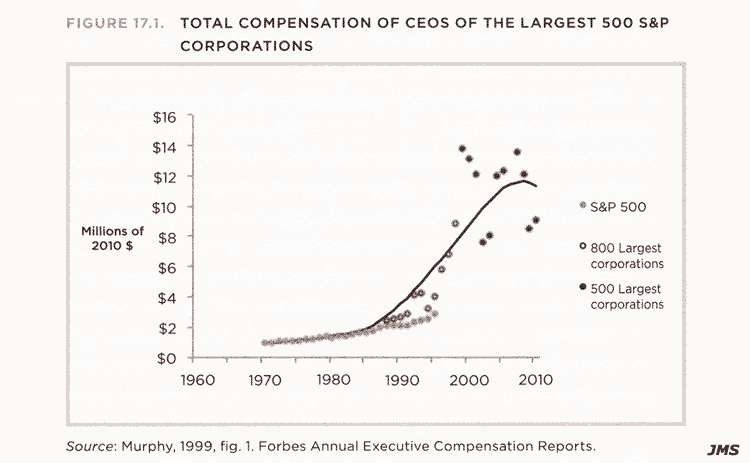
The second graph shows the rapid rise in executive compensation for America's CEOs. Murray describes the gigantic pay levels of today as "unseemly." In 1970, the average CEO made about $1MM in 2010 dollars. Now it has increased tenfold. No wonder the class/income gap is widening.
My only quibble with Murray's work is his reliance on IQ scores. I wish there were a way to quantitatively measure things like street smarts, ambition, savoir faire and cleverness. My life experience tells me that these attributes contribute far more to success and the ability to rise above poverty than Intelligence Quotient alone.
Having been born in 1943 (the same year as Charles Murray) and having lived a few miles from the 'Fishtown' portrayed in his book, I've seen the downward cultural trajectory Murray describes. He confirms my feeling that the lower classes are turning into a real-world version of The Jerry Springer Show. His data indicate that these changes are genuine as well as lasting and that the future for America is bleak. In the final chapters of the book, he posits several future scenarios, leaving the reader with a glimmer of hope. I'm skeptical that the trends can be reversed.
This is an excellent book that will give readers much to contemplate. Highly recommended. (posted 6/15/12, permalink)
'No, They Can't: Why Government Fails - But Individuals Succeed' by John Stossel
John Stossel is an Emmy Award-winning journalist, formerly of ABC, now with Fox Business Network. In this book, this professional skeptic and self-proclaimed libertarian deconstructs conventional wisdom about the role and effectiveness of our nation's government.
If you've watched many of Stossel's shows on television, you may find that some of the material in this book is repetitive. I've made quite a few postings on health care and education with views similar to the author's.
You may not agree with John on everything (his views on illegal drugs and defense spending made me uncomfortable) but the chapter on health care is a must-read, because he weaves many diverse sources, facts and data into a compact, cogent chapter.
This 300-or-so page book is an easy and thought-provoking read. Recommended. (posted 6/11/12, permalink)
'Waters of the World' by Henry J. Gambino
This book presents the majesty and awesome beauty of various bodies of water around the world in a series of 150 full-color photographs. Water is presented in all its forms: oceans, seas, bays, harbors, lakes, ponds, rivers, stream, canals, waterfalls, fountains, geysers, blowholes, rain, ice and snow. Photos were shot by the world-traveling author over a period of almost 50 years and are amazingly sharp with rich color. The photos span every continent except Antarctica.

Additional photos from the 1964-65 New York World's Fair can be seen here.
Dr. Gambino's last book (review here) was about the history of Argus cameras. (posted 6/1/12, permalink)
More book reviews are posted here.
Other Pages Of Interest
copyright 2012 - Joseph M. Sherlock - All applicable rights reserved
Disclaimer
The facts presented on this website are based on my best guesses and my substantially faulty geezer memory. The opinions expressed herein are strictly those of the author and are protected by the U.S. Constitution. Probably.
Spelling, punctuation and syntax errors are cheerfully repaired when I find them; grudgingly fixed when you do.
If I have slandered any brands of automobiles, either expressly or inadvertently, they're most likely crap cars and deserve it. Automobile manufacturers should be aware that they always have the option of trying to change my mind by providing me with vehicles to test drive.
If I have slandered any people or corporations, either expressly or inadvertently, they should buy me strong drinks (and an expensive meal) and try to prove to me that they're not the jerks I've portrayed them to be. If you're buying, I'm willing to listen.
Don't be shy - try a bribe. It might help.
|
|